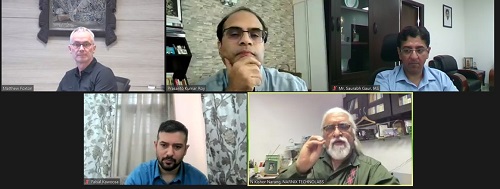Seamless User Experience and Collaborations to Help Unlock the Value for Federated Digital Identity

India is making fairly progressive advances in digital identity applications, and is well-positioned to make gains thanks to an active and collaborative ecosystem of market participants. The panel called for leveraging the power of federated digital identities to enable greater formalization of economic flows, promoting higher inclusion of individuals in a range of services, and allowing incremental digitization of sensitive interactions that require high levels of trust. Nonetheless, the need for Single Sign In, trustworthy architecture, interoperability, and seamless data sharing for accessing public and private services while enhancing user experience is crucial, to encourage the fast adoption of digital ID solutions.
 |
Panel Discussion: Federated Digital Identity – Techarc
The views were expressed at “Federated Digital Identity – What is there for stakeholders” webinar by industry experts and leaders like Mr. Matthew Foxton, India Regional President & Executive VP Branding & Communications, IDEMIA, Mr. Saurabh Gaur, IAS, Secretary IT, E&C, Skill Development & Training, CEO APCFSS, Govt of Andhra Pradesh, Mr. Prasanto K Roy, MD FTI Consulting’s Strategic Communications Practice and Distinguished Technology Commentator and Mr. N Kishor Narang, Principal Design Strategist and Architect, Narnix Technolabs Pvt. Ltd. The webinar was organized and moderated by Techarc, a leading technology analytics, research and consultancy firm.
Speaking on the webinar, Matthew Foxton, India Regional President & Executive VP Branding & Communications, IDEMIA, said, “India has massive advancements, particularly in terms of national programs and as a country is well-positioned to build digital identity-based solutions and services, Even though a digital identity is required for a wide variety of activities online, there is no “one-size-fits-all” approach to implementing ID and access systems. Matthew did emphasize on the importance of collaboration to make federated digital identity both accepted and trusted and feels there is a need for data protection law as it is a fundamental part of the federated id structure.”
Mr. Saurabh Gaur,IAS (Secretary (IT, Electronics & Communications; Skill Development & Training), CEO, APCFSS, Government of Andhra Pradesh) said, “From the policy perspective, the way government programmes are usually designed, they have a federated architecture. We have a lot to learn to understand from the private ecosystem, where innovators contribute, pick up the practices and make them a part of our enterprise architecture systems and this change has happened in the last few years. Every government policy that comes out today goes through a very thorough and elaborate process, with a built-in stakeholder consultation process.”
N Kishor Narang, Principal Design Strategist and Architect, Narnix Technolabs Pvt. Ltd. said, “India has already created a lot of interesting frameworks and set an example for the global ecosystem, people to follow in E-governance, and digitalization, but I think we can take this thought leadership a little further by using a systematic approach, to come up with a holistic, cyber-security, interoperability, trustworthiness and unified architecture platform for digital identity. I would like to have that kind of a thing that can extend to all kinds of use cases beyond a few government offices. Furthermore, we need to look at beyond the 17 well-recognized, accepted Sustainable Development Goals.”
Prasanto Kumar Roy, Managing Director, FTI Consultings Strategic Communications Practice, said, “Their should be a strong emphasis on improving the user experience for citizens while taking care of data protection and handling failures in a way that is not scary for the Citizen Service. UPI is a great example that has taken on the user experience part in a very major way and we would like to see the same built into the federated digital id system as well.”
“As we get digital identity implemented in India, there can be a lot of use cases to explore. Collaborations with entrepreneurs and students with companies like IDEMIA can identify use cases as per the problems and issues we face in India. In India we also have to think of regional diversity as well, as there are so many languages been spoken. We have to ensure that language doesnt become an issue for digital identity to work across the country. We also need to have a universal identity, something like Passport which can resolve issues like bots and fake identity,” Faisal Kawoosa, Moderator, Chief Analyst & Founder, Techarc.
The key takeaways that emerged from the panel discussion were that Preconditions for creating a federated digital infrastructure should include a level of digital infrastructure, sufficient trust in the ID provider, and a policy landscape that provides safeguards to individuals. Creating a federated digital id will go far towards unlocking noneconomic value, potentially furthering progress toward ideals that cannot be captured through quantitative analysis, including those of inclusion, rights protection, and transparency. Careful system design and well-considered government policies are required to promote uptake, mitigate risks like those associated with large-scale capture of personal data or systematic exclusion, and guard against the challenges of digital ID as a potential dual-use technology.
![]() This feed is automatically published via newsvoir.com
This feed is automatically published via newsvoir.com

